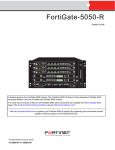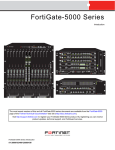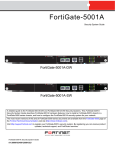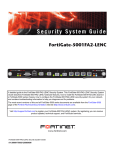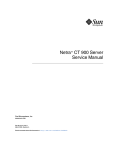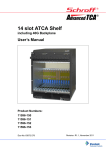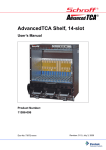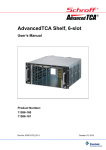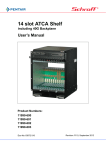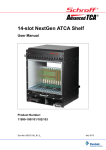Download Fortinet 3810A-LENC Network Card User Manual
Transcript
FortiGate-5140-R Chassis Guide 5140SAP 5140 13 11 9 7 5 3 1 T SE RE 2 SERIAL 1 SERIAL 2 ALARM 2 3 1 AL OR R ITIC MAJ MINO USER USER USER CR 4 6 8 10 12 14 5000SM 10/100 link/Act 10/100 link/Act ETH0 ETH1 ETH0 Service RESET STATUS Hot Swap 12 5000SM 10/100 link/Act 10/100 link/Act ETH0 ETH1 ETH0 Service RESET STATUS Hot Swap FILTER 0 FA N TR AY 1 FAN TR AY 2 FAN TR AY A detailed guide to the FortiGate-5140 chassis. This FortiGate-5140-R Chassis Guide describes FortiGate-5140 hardware features, and how to install the FortiGate-5140 chassis. The most recent versions of this and all FortiGate-5000 series documents are available from the FortiGate-5000 page of the Fortinet Technical Documentation web site (http://docs.forticare.com). Visit http://support.fortinet.com to register your FortiGate-5140-R chassis. By registering you can receive product updates, technical support, and FortiGuard services. FortiGate-5140-R Chassis Guide 01-30000-87705-20090108 Warnings and cautions Warnings and cautions Only trained and qualified personnel should be allowed to install or maintain FortiGate-5000 series equipment. Read and comply with all warnings, cautions and notices in this document. CAUTION: Risk of Explosion if Battery is replaced by an Incorrect Type. Dispose of Used Batteries According to the Instructions. Caution: You should be aware of the following cautions and warnings before installing FortiGate-5000 series hardware 2 • Turning off all power switches may not turn off all power to the FortiGate-5000 series equipment. Some circuitry in the FortiGate-5000 series equipment may continue to operate even though all power switches are off. • Many FortiGate-5000 components are hot swappable and can be installed or removed while the power is on. But some of the procedures in this document may require power to be turned off and completely disconnected. Follow all instructions in the procedures in this document that describe disconnecting FortiGate-5000 series equipment from power sources, telecommunications links and networks before installing, or removing FortiGate-5000 series components, or performing other maintenance tasks. Failure to follow the instructions in this document can result in personal injury or equipment damage. • Install FortiGate-5000 series chassis at the lower positions of a rack to avoid making the rack top-heavy and unstable. • Do not insert metal objects or tools into open chassis slots. • Electrostatic discharge (ESD) can damage FortiGate-5000 series equipment. Only perform the procedures described in this document from an ESD workstation. If no such station is available, you can provide some ESD protection by wearing an anti-static wrist strap and attaching it to an available ESD connector such as the ESD sockets provided on FortiGate-5000 series chassis. • Make sure all FortiGate-5000 series components have reliable grounding. Fortinet recommends direct connections to the building ground. • If you install a FortiGate-5000 series component in a closed or multi-unit rack assembly, the operating ambient temperature of the rack environment may be greater than room ambient. Make sure the operating ambient temperature does not exceed Fortinet’s maximum rated ambient temperature. • Installing FortiGate-5000 series equipment in a rack should be such that the amount of airflow required for safe operation of the equipment is not compromised. • FortiGate-5000 series chassis should be installed by a qualified electrician. • FortiGate-5000 series equipment shall be installed and connected to an electrical supply source in accordance with the applicable codes and regulations for the location in which it is installed. Particular attention shall be paid to use of correct wire type and size to comply with the applicable codes and regulations for the installation / location. Connection of the supply wiring to the terminal block on the equipment may be accomplished using Listed wire compression lugs, for example, Pressure Terminal Connector made by Ideal Industries Inc. or equivalent which is suitable for AWG 10. Particular attention shall be given to use of the appropriate compression tool specified by the compression lug manufacturer, if one is specified. FortiGate-5140-R Chassis Guide 01-30000-87705-20090108 http://docs.fortinet.com/ • Feedback Contents Contents Warnings and cautions................................................................................................... 2 FortiGate-5140 chassis............................................................................ 5 FortiGate-5140 chassis front panel ............................................................................... 6 FortiGate-5140 chassis back panel ............................................................................... 7 Physical description of the FortiGate-5140 chassis .................................................... 8 FortiGate-5140 shelf managers...................................................................................... 8 Shelf Manager fan and power control....................................................................... 10 FortiGate-5140 shelf alarm panel................................................................................. 10 Shelf alarm panel telco alarms ................................................................................. 11 Shelf manager command line interface (CLI) ............................................................. 12 Connecting to the shelf manager CLI using a serial port.......................................... 12 Air filter .......................................................................................................................... 14 Cooling fan trays........................................................................................................... 15 Power connection and configuration................................................... 17 About data center DC power........................................................................................ 17 Connecting a FortiGate-5140 chassis to data center DC power and data center ground ................................................................................................ 17 Connecting a FortiGate-5140 PEM to data center DC power................................... 18 Connecting the FortiGate-5140 chassis to data center ground ................................ 19 Connecting the FortiGate-5140 chassis to AC power using the FortiGate-5053 power converter tray .......................................................................... 20 FortiGate-5053 power converter tray front and back panel ...................................... Selecting the power supplies and power convertor trays that you need for your FortiGate-5140 configuration.............................................................. Connecting a FortiGate-5140 chassis to the FortiGate-5053 power converter tray ................................................................................................. Connecting the FortiGate-5140 chassis to data center ground ................................ 21 22 25 27 Turning on FortiGate-5140 chassis power ................................................................. 27 FortiGate-5140 hardware procedures .................................................. 29 Mounting the FortiGate-5140 chassis ......................................................................... 29 Air flow ...................................................................................................................... 29 Inserting 5000-series modules into a FortiGate-5140 chassis.................................. 29 Using FortiSwitch-5003A and FortiSwitch-5003 boards for backplane communication.............................................................................................................. 30 FortiGate-5140-R Chassis Guide 01-30000-87705-20090108 http://docs.fortinet.com/ • Feedback 3 Contents For more information............................................................................. 31 Fortinet documentation ................................................................................................ 31 Fortinet Tools and Documentation CD ..................................................................... 31 Fortinet Knowledge Center ...................................................................................... 31 Comments on Fortinet technical documentation ..................................................... 31 Customer service and technical support.................................................................... 31 Register your Fortinet product .................................................................................... 31 4 FortiGate-5140-R Chassis Guide 01-30000-87705-20090108 http://docs.fortinet.com/ • Feedback FortiGate-5140 chassis FortiGate-5140 chassis You can install up to 14 FortiGate-5000 series boards in the 14 front panel slots of the FortiGate-5140 ATCA chassis. The FortiGate-5140 is a 12U chassis that contains two redundant hot swappable DC power entry modules that connect to -48 VDC Data Center DC power. The FortiGate-5140 chassis also includes three hot swappable cooling fan trays and a front accessible air filter. If all 14 front panel slots contain FortiGate-5005A2, FortiGate-5001SX, or FortiGate-5001FA2 boards the FortiGate-5140 chassis provides a total of 112 FortiGate gigabit ethernet interfaces. If all 14 slots contain FortiGate-5001A boards the FortiGate-5140 chassis supports 28 1-Gigabit ethernet FortiGate interfaces. If you add FortiGate-ADM-XB2 modules to the FortiGate-5001A boards the FortiGate-5140 chassis supports another 28 10-Gigabit interfaces. You can also install a FortiSwitch-5003A or FortiSwitch-5003 board in the FortiGate-5140 chassis to provide base backplane communications. Base backplane communications can be used for HA heartbeat communications and for data communications. You can add a second FortiSwitch-5003A or FortiSwitch-5003 board for redundancy. FortiSwitch-5003A boards can also provide fabric backplane communication using the FortiGate-5140 fabric backplane channels. You can mix and match any combination of FortiGate-5000 series boards in the FortiGate-5140 chassis. For example, you could install four FortiGate-5005FA2 boards, four FortiGate-5001SX boards, and four FortiGate-5001FA2 boards. You can also install FortiController-5208 and FortiGate-5005FA2 boards in a FortiGate-5140 chassis to create a FortiGate-5005-DIST security system. Some of the boards installed in a FortiGate-5140 chassis can be operating in a FortiGate HA cluster and some can be operating as standalone FortiGate units. You can also operate multiple HA clusters and standalone FortiGate units in a single FortiGate-5140 chassis. You can also use FortiSwitch-5003A or FortiSwitch-5003 boards to operate HA clusters consisting of FortiGate-5000 series boards installed in multiple FortiGate-5000 chassis. You can also use FortiSwitch-5003A boards for fabric data communication between chassis. The FortiGate-5140 chassis also includes 14 rear transition module (RTM) slots. The FortiGate-5050 chassis supports 10-gigabit fabric channel communication if you have installed FortiGate-5001A boards with FortiGate-RTM-XB2 modules and one or two FortiSwitch-5003A boards. The FortiGate-5140 chassis requires -48VDC Data Center DC power. If DC power is not available you can install a FortiGate-5053 power converter tray (purchased separately) with FortiGate-5140 power supplies. This chapter describes the FortiGate-5140 chassis and includes the following sections: • FortiGate-5140 chassis front panel • FortiGate-5140 chassis back panel • Physical description of the FortiGate-5140 chassis • FortiGate-5140 shelf managers • FortiGate-5140 shelf alarm panel • Shelf manager command line interface (CLI) • Air filter • Cooling fan trays FortiGate-5140-R Chassis Guide 01-30000-87705-20090108 http://docs.fortinet.com/ • Feedback 5 FortiGate-5140 chassis front panel FortiGate-5140 chassis FortiGate-5140 chassis front panel Figure 1 shows the front panel of a FortiGate-5140 chassis. Two FortiSwitch-5003A boards are installed in slots 1 and 2. Twelve FortiGate-5001A-DW boards installed in slots 3 to 14. Figure 1: FortiGate-5140 chassis front panel with FortiGate-5001A-DW and FortiSwitch-5003A boards installed FortiGate-5001A-DW FortiGate-5001A-DW boards boards slots 3, 5, 7, 9, FortiSwitch-5003A slots 4, 6, 8, 10, boards 11, and 13 12, and 14 slots 1 and 2 ESD socket 5140SAP 5140 13 11 9 7 5 3 1 T SE RE 2 SERIAL 1 SERIAL 2 Shelf alarm panel (SAP) ALARM R AL R R2 R1 R3 ITIC MAJO MINO USE USE USE CR 4 6 8 10 12 14 Slot numbers 5000SM 10/100 link/Act 10/100 link/Act ETH0 ETH1 ETH0 Service RESET STATUS Primary shelf manager Hot Swap 12 5000SM 10/100 link/Act 10/100 link/Act ETH0 ETH1 ETH0 Service RESET STATUS Secondary shelf manager Hot Swap Front accessible air filter FILTER Front cable tray Cooling fan trays 0, 1, 2 0 FAN TRAY 1 FAN TRAY 2 FAN TRAY The FortiGate-5140 shelf alarm panel (SAP) and primary and secondary FortiGate-5140 Shelf Managers are also visible. The factory installed shelf alarm panel displays alarms, provides a telco alarm interface, and also provides serial connections to the shelf managers. The factory installed shelf managers provide power distribution, cooling, alarms, and shelf status for the FortiGate-5140 chassis. For more information about these components, see “FortiGate-5140 shelf alarm panel” on page 10 and “FortiGate-5140 shelf managers” on page 8. Caution: Do not operate the FortiGate-5140 chassis with open slots on the front panel. For optimum cooling performance and safety, the slots must contain a FortiGate-5000 series board or an air baffle slot filler. As well the removable terminal block cover must be installed over the power connectors on the back of the chassis. 6 FortiGate-5140-R Chassis Guide 01-30000-87705-20090108 http://docs.fortinet.com/ • Feedback FortiGate-5140 chassis FortiGate-5140 chassis back panel Also visible on the front of the FortiGate-5140 chassis: • Electrostatic discharge (ESD) socket, used for connecting an ESD wrist or ankle band when working with the chassis. • Front cable tray, used for managing and securing ethernet and other cables. • Front accessible air filter. • Three hot swappable FortiGate-5140 cooling fan trays. FortiGate-5140 chassis back panel Figure 2 on page 7 shows the back panel of the FortiGate-5140 chassis. The back panel includes two hot-swappable redundant -48V/-60 VDC power entry modules (PEMs) labelled A and B. Fortinet ships the FortiGate-5140 chassis with PEM A and B installed. The PEMs provide redundant DC power connections for the FortiGate-5140 chassis and distribute DC power to the chassis slots and to the fan trays. Figure 2: FortiGate-5140 chassis back panel RTM slot filler panels Back cable tray ESD socket 14 12 10 8 PEM 6 Chassis ground connector (green) 3 2 1 3 5 7 B -48V/-60 VDC nom 4 4 2 1 11 3 2 -48V/-60 VDC nom 1 13 A PEM RETURN 4 9 RTM slot numbers RETURN 4 3 2 1 4 3 2 1 4 3 2 1 4 3 2 1 TERMINAL BLOCK COVER 4 Remove terminal block cover and decable before removing PEM. 3 2 1 4 3 2 1 A PEM B PEM -48V/-60 VDC RTN nom (black) (red) Power Entry Module B -48V/-60 VDC RTN nom (black) (red) Power Entry Module A (terminal block cover removed) TERMINAL BLOCK COVER Remove terminal block cover and decable before removing PEM. If you require redundant power you should connect both PEMs to DC power. If redundant power is not required, you should connect PEM A to DC power. Each PEM has four -48V/-60 VDC connectors and 4 RTN connections. All eight of these connectors should be connected to DC power. Figure 2 on page 7 shows the terminal block cover removed from PEM A and the wiring required to connect PEM A to DC power. While operating the FortiGate-5140 both terminal block covers should be installed. FortiGate-5140-R Chassis Guide 01-30000-87705-20090108 http://docs.fortinet.com/ • Feedback 7 Physical description of the FortiGate-5140 chassis FortiGate-5140 chassis For detailed information about connecting power to the FortiGate-5140 chassis, see “Connecting a FortiGate-5140 chassis to data center DC power and data center ground” on page 17 or “Connecting the FortiGate-5140 chassis to AC power using the FortiGate-5053 power converter tray” on page 20. The power entry modules are hot swappable, which means you can remove and replace a defective PEM while the FortiGate-5140 is operating assuming that the FortiGate-5140 system has both PEMs connected to DC power for redundancy. The back panel also includes the back cable tray, an ESD socket and the chassis ground connector. The ground connector must be connected to Data Center ground (see “Connecting the FortiGate-5140 chassis to data center ground” on page 27). Use the back cable tray for securing and managing DC power, RTN, and ground wires. The back panel also contains 14 RTM slots numbered to correspond to the front panel slots. The RTM slots are available for FortiGate-5000 RTM modules such as the FortiGate-RTM-XB2 module. When the FortiGate-5140 chassis is shipped, these slots are covered by RTM slot filler panels. Physical description of the FortiGate-5140 chassis The FortiGate-5140 chassis is a 12U chassis that can be installed in a standard 19-inch rack. Table 1 describes the physical characteristics of the FortiGate-5140 chassis. Table 1: FortiGate-5140 chassis physical description Dimensions 21 x 19 x 20.6 in. (53.3 x 48.3 x 52.4 cm) (Height x Width x Depth) Shipping weight completely assembled with packaging 110 lb. (50 kg) Operating environment Temperature: 32 to 104°F (5 to 45°C) Relative humidity: 5 to 85% (Non-condensing) Storage environment Temperature: -13 to 158°F (-25 to 70°C) Relative humidity: 5 to 85% (Non-condensing) Power consumption Maximum: 2,980W DC Power input 2x redundant -37VDC to -72VDC, 30A per power feed (total 4 + 4 power feeds) FortiGate-5140 shelf managers The FortiGate-5140 chassis includes one or two redundant hot-swappable shelf managers, located in the dedicated shelf manager slots on the right of the FortiGate-5140 front panel. The primary shelf manager is installed above the secondary shelf manager. The shelf managers support redundant operation with automatic switchover. If both shelf managers are operating normally, one acts as the active shelf manager and the other as the standby. Usually the primary shelf manager would be the active shelf manager and the secondary shelf manager would be the standby shelf manager. The shelf managers monitor each other and either can trigger a switchover if necessary. The active shelf manager performs all shelf manager functions. If the active shelf manager fails or is removed, the standby shelf manager takes over all shelf manager functions. 8 FortiGate-5140-R Chassis Guide 01-30000-87705-20090108 http://docs.fortinet.com/ • Feedback FortiGate-5140 chassis FortiGate-5140 shelf managers The FortiGate-5140 shelf managers control chassis power up and power down, chassis power distribution, monitor chassis operating parameters, monitor and control chassis cooling, and can signal alarms if the chassis encounters problems. All FortiGate-5000 modules installed in the chassis communicate with the shelf managers. The FortiGate-5140 shelf managers are factory installed. In most cases users do not have to install or configure the shelf managers. Each shelf manager has two ethernet interfaces (ETH 0 and ETH 1). You can connect to ETH 0 from the shelf manager front panel. ETH 1 connects to the FortiGate-5140 backplane. The shelf managers detect alarm conditions and communicate alarm signals to the FortiGate-5140 shelf alarm panel. The shelf alarm panel also contains serial interfaces for connecting to the shelf managers. The shelf managers are hot swappable. You can remove a shelf manager by opening the extraction lever until the hot swap LED starts blinking. When the hot swap LED turns solid blue you can remove the shelf manager from the FortiGate-5140 chassis. Figure 3: FortiGate-5140 shelf manager front panel Retention ETH0 Screw 100base-T Ethernet STATUS RESET ETH0 Service ETH0 ETH1 5000SM 10/100 link/Act 10/100 link/Act Status LEDs Hot Swap Hot Swap LED ETH 0 and 1 network Reset activity LEDs Button Handle Table 2: FortiGate-5140 shelf manager LEDs LED State Description ETH 0 10/100 ETH 1 link/Act Yellow The Ethernet interface is connected at 100 Mbps. Green Blinking LED indicates network traffic. Off No link. Green This shelf manager is operating normally as the active shelf manager. Usually the primary shelf manager operates as the active shelf manager. Red This shelf manager is operating normally as the backup shelf manager. Usually the secondary shelf manager operates as the standby shelf manager. Off The shelf manager is not ready to be removed. Blue The shelf manager is ready to be removed. Long blink The shelf manager is starting up after being inserted into the chassis. Short blink The shelf manager is shutting down in preparation for being removed from the chassis. STATUS HOT SWAP FortiGate-5140-R Chassis Guide 01-30000-87705-20090108 http://docs.fortinet.com/ • Feedback 9 FortiGate-5140 shelf alarm panel FortiGate-5140 chassis Shelf Manager fan and power control The FortiGate-5140 shelf managers monitor the internal temperature of the FortiGate-5140 chassis and adjust the operating speed of the FortiGate-5140 chassis cooling fans as required. When the chassis is first powered on all cooling fans run at full speed. Once the shelf manager is up and running, the shelf manager reduces cooling fan speeds to maintain an optimum temperature in the chassis. If shelf managers are not installed or not operating correctly the FortiGate-5140 chassis cooling fans always operate at full speed. FortiGate-5140 shelf alarm panel The FortiGate-5140 shelf alarm panel (SAP), located at the top of the FortiGate-5140 front panel, provides LED indicators of FortiGate-5140 alarms, a telco alarm connector, an alarm LED reset button, and console access to the FortiGate-5140 shelf managers. The LED alarm indicators include critical, major, and minor alarms as well as three user defined alarms. The alarm LED reset button (RESET) on the shelf alarm panel activates the Alarm Cutoff (ACO) state. When ACO is activated, the active alarm LEDs blink and all of the alarm relays are deactivated. Figure 4: FortiGate-5140 shelf alarm panel front panel Minor Alarm (Amber) Major Alarm (Red) Critical Alarm (Red) User 1 Alarm (Amber) User 2 Alarm (Amber) User 3 Alarm (Amber) 5140SAP T SE RE SERIAL 1 SERIAL 2 ALARM AL OR R R2 R1 R3 ITIC MAJ MINO USE USE USE CR Retention Alarm Screw LED Reset Button SERIAL 1 (Primary Shelf Manager) Telco Alarm Interface Retention Screw SERIAL 2 (Secondary Shelf Manager) Table 3: FortiGate-5140 shelf alarm panel LEDs LED State Description CRITICAL Off Normal operation. MAJOR MINOR USER1 USER2 USER3 10 Red Indicates a critical alarm. Blinking Red Alarm cutoff (ACO) activated by pressing the alarm LED reset button. Off Normal operation. Red Indicates a major alarm. Blinking Red Alarm cutoff (ACO) activated by pressing the alarm LED reset button. Off Normal operation. Amber Indicates a minor alarm. Blinking Amber Alarm cutoff (ACO) activated by pressing the alarm LED reset button. Off Normal operation Amber Indicates a user-definable alarm. Blinking Amber Alarm cutoff (ACO) activated by pressing the alarm LED reset button. FortiGate-5140-R Chassis Guide 01-30000-87705-20090108 http://docs.fortinet.com/ • Feedback FortiGate-5140 chassis FortiGate-5140 shelf alarm panel Table 4: FortiGate-5140 shelf alarm panel connectors Connector Type Speed Protocol Description SERIAL 1 RJ-45 9600 bps, 8/N/1 RS-232 serial Serial connection to the primary shelf manager command line interface. SERIAL 2 RJ-45 9600 bps, 8/N/1 RS-232 serial Serial connection to the secondary shelf manager command line interface. ALARM micro DB-15 male N/A Telco Form-c The external dry relay Telco alarm interface (48VDC) provides Telco form-c relay connections for minor, major and critical power faults. The cable required to connect to the alarm interface is not supplied by Fortinet. Figure 5 shows the connections between the primary and secondary shelf managers and the shelf alarm panel. Figure 5: Connections between the shelf managers and the shelf alarm panel 5140SAP ALARM ShMM-500 Secondary Shelf Manager (Lower) CH0 Master-Only I²C-bus Buffer LTC4300 I²C-Switch PCA9545 Enable Serial Console Interface CH3 CH0 Master-Only I²C-bus Buffer LTC4300 I²C-Switch PCA9545 Enable Serial Console Interface SERIAL 2 L R R2 R1 R3 CA OR ITI MAJ MINO USE USE USE CR CH3 T SE RE SERIAL 1 ShMM-500 Primary Shelf Manager (Upper) Shelf alarm panel telco alarms The shelf alarm panel telco alarm interface relay circuits are capable of carrying 60 VDC or 1 A with a max. rating of 30 VA. The shelf alarm panel accepts timed pulse inputs for clearing minor and major alarm states. Reset is accomplished by asserting a voltage differential from 3.3 V to 48 V for between 200 and 300 ms. The acceptance voltage range is from 0 to 48 VDC continuous (handles up to 60 VDC at a 50% duty cycle). The current drawn by a reset input does not exceed 12 mA. The alarm LED reset button activates the alarm cutoff (ACO) state for major, minor, and user-defined alarms. You cannot reset critical alarms with the alarm LED reset button. When the ACO state is activated, active alarm LEDs blink and all of the alarm relays are deactivated. The alarm reset button activates the ACO state but does not clear the alarm completely. FortiGate-5140-R Chassis Guide 01-30000-87705-20090108 http://docs.fortinet.com/ • Feedback 11 Shelf manager command line interface (CLI) FortiGate-5140 chassis Figure 6: The telco alarm connector (DB-15 male) 15 9 1 8 Table 5: Telco alarm connector pin assignment Pin Name Description 1 AMIR+ MinorReset+ 2 AMIR- MinorReset- 3 AMAR+ MajorReset+ 4 AMAR- MajorReset- 5 ACNO CriticalAlarm - NO 6 ACNC CriticalAlarm - NC 7 ACCOM CriticalAlarm - COM 8 AMINO MinorAlarm -NO 9 AMINC MinorAlarm - NC 10 AMINCOM MinorAlarm - COM 11 AMANO MajorAlarm - NO 12 AMANC MajorAlarm - NC 13 AMACOM MajorAlarm - COM 14 APRCO PwrAlarm - NO 15 APRCOM PwrAlarm - COM Shield Shelf-GND Shelf Ground Shelf manager command line interface (CLI) You can use the shelf manager CLI to communicate with the intelligent management controllers of the chassis, with boards in the chassis, and with the shelf manager itself. The CLI is an IPMI-based set of commands that can be accessed directly or through a higher-level management application or a script. Using the CLI, you can access information about the current state of the chassis including current board population, current sensor values, threshold settings, recent events, and overall chassis health. Connecting to the shelf manager CLI using a serial port You can connect to the shelf manager CLI by connecting the console cable supplied with your chassis to a management PC console port and to the appropriate shelf alarm panel serial port. To connect to the primary shelf manager use Serial 1. To connect to the secondary shelf manager use Serial 2. 12 FortiGate-5140-R Chassis Guide 01-30000-87705-20090108 http://docs.fortinet.com/ • Feedback FortiGate-5140 chassis Shelf manager command line interface (CLI) Figure 7: Connecting to a shelf manager serial port SERIAL 2 (Secondary Shelf Manager) SERIAL1 (Primary Shelf Manager) FortiGate-5140 5140SAP T SE RE SERIAL 1 SERIAL 2 Shelf Alarm Panel ALARM L R R2 R1 R3 CA OR ITI MAJ MINO USE USE USE CR Fortinet RJ-45 to 9-pin Console Cable To PC RS-232 Console Port To connect to the shelf manager CLI using a shelf alarm panel serial port 1 Connect the Fortinet console cable to the shelf alarm panel Serial 1 or Serial 2 port (see Figure 7). 2 Connect the Fortinet console cable to your PC or other device RS-232 console port. 3 Start a terminal emulation program (for example, HyperTerminal) on the management computer. Use these settings: Baud Rate (bps) 9600 Data bits 8 Parity None Stop bits 1 Flow Control None 4 Press enter to connect to the CLI. 5 At the login prompt enter the shelf manager user name and password. The default user name is root with no password. When you log into the shelf manager CLI you are logging into a Linux shell as root. You can begin entering commands at the # prompt: # To add or change the shelf manager root account password For enhanced security you should use the following steps to add a password for the shelf manager root account. 1 At the # prompt enter the following Linux command to add a password for the root account: # passwd FortiGate-5140-R Chassis Guide 01-30000-87705-20090108 http://docs.fortinet.com/ • Feedback 13 Air filter FortiGate-5140 chassis 2 Enter and confirm a new password for the root account. The password should be between 5 and 8 characters long and should include a combination of upper and lower case letters and numbers. You can use the passwd command to change the root account password at any time. You can also use the passwd command to remove the root account. Enter the passwd command and when prompted for a password, press enter to add a blank password. To use the shelf manager command line interface agent (CLIA) Once you have logged into the shelf manager CLI you use the Command Line Interface Agent (CLIA) to enter shelf manager commands. Usually you do this from the Linux command line by entering clia followed by the required CLIA command verb and parameters. The CLIA executable connects to the main Shelf Manager software process, passes the command information to it and retrieves the results. For example, you can enter the following command to list the most commonly used CLIA commands: clia help You can also the help command to get more information about specific CLIA commands. For example, use the following command display help for the shelf pwrreorder command: clia help shelf pwrreorder Pigeon Point Shelf Manager Command Line Interpreter Change the order of FRU Activation and Power Descriptors instead of <addr> <fru_id> user may use: board <N> shm <N> power_supply <N> (valid in 2.x systems only) fan_tray <N> PwrReorder <addr1> <fru_id1> before/after <addr2> <fru_id2> Air filter The FortiGate-5140 chassis includes a front accessible air filter. This filter must be in place for the FortiGate-5140 chassis to operate normally. If the air filter is not locked into place this is detected by an air filter presence switch. Air filters should be inspected regularly and cleaned if dirty or replaced if damaged. If the filter becomes dirty, clean it with a vacuum or with compressed air. The filter meets the requirements of the Telcordia Technologies Generic Requirements GR-78-CORE specification. The air filter can be removed by pulling the air filter handle on the front of the FortiGate-5140 chassis. To install a new filter, push the air filter into the guide rails at each side of the shelf until the filter locks into place. 14 FortiGate-5140-R Chassis Guide 01-30000-87705-20090108 http://docs.fortinet.com/ • Feedback FortiGate-5140 chassis Cooling fan trays Cooling fan trays The FortiGate-5140 chassis contains three interchangeable hot-swappable cooling fan trays installed at the front bottom of the chassis. You can remove any fan tray by lifting the front cable tray, pressing the hot swap button on the tray front panel, fully loosening the mounting knots, and then pulling the fan tray out using the extraction handle. Each cooling fan tray contains two radial fans for cooling the modules installed in the FortiGate-5140 chassis. Fan speeds are monitored by a tachometer signal sent from the cooling fan trays to the shelf manager. The shelf manager regulates the fan speed by adjusting the DC voltage supplied to the fan trays. Figure 8: Cooling fan tray front panel FAN T R AY OK LED Alarm LED Hot swap LED Hot swap button Table 6: FortiGate-5140 fan tray LEDs and controls LED/Control Description OK (operate) LED Green when the fan tray is powered and operating normally. Alarm LED Normally off. Turns red when there is a problem with the fan tray. HS (hot swap) LED Normally off. Blinking blue indicates that the fan tray is entering the hot swap mode. Solid Blue indicates that the fan tray is in hot swap mode and can be removed from the chassis. HS (hot Press the HS button to enter hot swap mode. When the HS LED becomes swap) button solid blue you can remove the fan tray from the chassis. FortiGate-5140-R Chassis Guide 01-30000-87705-20090108 http://docs.fortinet.com/ • Feedback 15 Cooling fan trays 16 FortiGate-5140 chassis FortiGate-5140-R Chassis Guide 01-30000-87705-20090108 http://docs.fortinet.com/ • Feedback Power connection and configuration Power connection and configuration This chapter describes how to connect data center DC power to a FortiGate-5140 chassis. If data center DC power is not available, this document also describes how to use the FortiGate-5053 power convertor tray to supply DC power to the FortiGate-5140 chassis. This chapter describes: • About data center DC power • Connecting a FortiGate-5140 chassis to data center DC power and data center ground • Connecting the FortiGate-5140 chassis to AC power using the FortiGate-5053 power converter tray • Turning on FortiGate-5140 chassis power About data center DC power The FortiGate-5140 chassis is designed to be installed in a data center or similar location that has available -48VDC power (also called battery power). Fortinet expects that most FortiGate-5140 customers will be installing their FortiGate equipment in a data center or similar location that is already equipped with a -48VDC power system that provides power to existing networking or telecom equipment. The FortiGate-5140 chassis are designed to be connected directly to this DC power system. In this document, data center DC power refers to a -48VDC power system that is already available at the location at which the FortiGate-5140 chassis is being installed. Connecting a FortiGate-5140 chassis to data center DC power and data center ground Connect the FortiGate-5140 chassis to data center DC power using the redundant power entry modules (PEMs) on the FortiGate-5140 back panel. Fortinet supplies and recommends AWG-14 stranded wires for all power connections: Black for -48VDC and red for RTN. Green AWG-6 wires are recommended for ground connections. If required, install terminal lugs on the wires before connecting them to the PEM terminal strips. Connect all eight of the terminals on the PEM terminal strips, four black -48VDC connections and four red RTN connections. Each FortiGate-5140 PEM includes 4 connectors that connect power to 4 different power zones in the FortiGate-5140 chassis. Each power zone supplies power to different FortiGate-5140 slots and cooling fan trays. You should always connect all 4 power zones. If you are connecting both PEMs the -48VDC and RTN terminals on PEM A and PEM B must be wired symmetrically. This means that the connections must be the same to both PEMs. FortiGate-5140 PEMs are hot-swappable, which means you can remove and replace a defective PEM while the system is operating (assuming that the FortiGate-5140 system has both PEMs connected for redundancy). It is not necessary to notify the software or reset the system power. You can add, remove, or replace a second PEM without interrupting FortiGate-5140 operation. FortiGate-5140-R Chassis Guide 01-30000-87705-20090108 http://docs.fortinet.com/ • Feedback 17 Connecting a FortiGate-5140 chassis to data center DC power and data center ground This section describes: • Connecting a FortiGate-5140 PEM to data center DC power • Connecting the FortiGate-5140 chassis to data center ground Connecting a FortiGate-5140 PEM to data center DC power The following procedure describes how to connect power to PEM A. You can repeat this procedure to connect PEM B. Figure 9: Connecting a FortiGate-5140 PEM to data center DC power Data Center -48VDC connector Data Center RTN connector -48V/-60 VDC black to Data Center -48VDC -48V -48V/-60 VDC nom Hot swap LED RTN (positive) red to Data Center RTN RTN RETURN 4 3 2 1 4 3 2 1 4 3 2 1 4 3 2 1 Alarm LED OK LED Hot swap button PEM -48V/-60 VDC nom terminal strip connectors 1, 2, 3, 4 TERMINAL BLOCK COVER RTN (positive) terminal strip connectors 1, 2, 3, 4 Remove terminal block cover and decable before removing PEM. Table 7: FortiGate-5140 PEM LEDs and controls LED/Control Description HS (hot swap) LED Normally off. Blinking blue indicates that the PEM is entering the hot swap mode. Solid Blue indicates that the PEM is in hot swap mode and can be removed from the chassis. Alarm LED Normally off. Turns red when there is a problem with the power source, or if one or more of the 8 PEM fuses are blown or missing. OK (operate) LED Green when the PEM is powered and operating normally. HS (hot Press the HS button to enter hot swap mode. When the HS LED becomes swap) button solid blue you can remove the PEM from the chassis. You need the following tools and equipment to connect a FortiGate-5140 PEM to data center DC power: 18 • A number 2 Phillips screwdriver. • An electrostatic discharge (ESD) preventive wrist or ankle strap with connection cord. • Four black AWG-14 stranded wires with terminal lugs attached and labelled -48V. • Four red AWG-14 stranded wires with terminal lugs attached and labelled RTN. FortiGate-5140-R Chassis Guide 01-30000-87705-20090108 http://docs.fortinet.com/ • Feedback Power connection and configuration To connect a FortiGate-5140 PEM to data center DC power 1 Attach the ESD wrist strap to your wrist and to an ESD socket or to a bare metal surface on the chassis or frame. 2 Loosen the screws and remove the terminal block cover from the FortiGate-5140 PEM. 3 Connect the DC power wires (see Figure 9): • Connect a black -48V power wire from the data center DC power source to connector 1 on the FortiGate-5140 PEM terminal strip labeled -48V/-60 VDC nom. • Connect a black -48V power wire from the data center DC power source to connector 2 on the FortiGate-5140 PEM terminal strip labeled -48V/-60 VDC nom. • Connect a black -48V power wire from the data center DC power source to connector 3 on the FortiGate-5140 PEM terminal strip labeled -48V/-60 VDC nom. • Connect a black -48V power wire from the data center DC power source to connector 4 on the FortiGate-5140 PEM terminal strip labeled -48V/-60 VDC nom. • Connect a red RTN return wire from data center RTN to connector 1 on the FortiGate-5140 PEM terminal strip labeled RTN. • Connect a red RTN return wire from data center RTN to connector 2 on the FortiGate-5140 PEM terminal strip labeled RTN. • Connect a red RTN return wire from data center RTN to connector 3 on the FortiGate-5140 PEM terminal strip labeled RTN. • Connect a red RTN return wire from data center RTN to connector 4 on the FortiGate-5140 PEM terminal strip labeled RTN. 4 Secure the power cabling to the chassis using tie wraps and the back cable tray. 5 If required, label the black wires -48V. 6 If required, label the red wires RTN. 7 Re-attach the terminal block cover to the FortiGate-5140 PEM. Connecting the FortiGate-5140 chassis to data center ground The FortiGate-5140 chassis includes a ground terminal on the lower left side of the FortiGate-5140 back panel (see Figure 2 on page 7). The shelf ground terminal provides two M6 bolts to connect a double-lug ground terminal cable. This connector must be connected to data center ground. You need the following tools and equipment to connect the FortiGate-5140 chassis to ground: • A number 2 Phillips screwdriver. • An electrostatic discharge (ESD) preventive wrist or ankle strap with connection cord. • One green AWG-6 stranded wire with terminal lug with 45° angle tongue attached. FortiGate-5140-R Chassis Guide 01-30000-87705-20090108 http://docs.fortinet.com/ • Feedback 19 Connecting the FortiGate-5140 chassis to AC power using the FortiGate-5053 power converter tray Figure 10: Connecting a FortiGate-5140 chassis to data center ground Chassis ground connector (green) FortiGate-5140 Ground connector GND Data Center ground connector To connect the FortiGate-5140 chassis to data center ground 1 Attach the ESD wrist strap to your wrist and to an ESD socket or to a bare metal surface on the chassis or frame. 2 Connect the green ground wire from the data center ground to the ground connector on the FortiGate-5140 chassis (see Figure 10). 3 Secure the ground wire to the chassis using tie wraps and the back cable tray. 4 Optionally label the ground wire GND. Connecting the FortiGate-5140 chassis to AC power using the FortiGate-5053 power converter tray If data center DC power is not available, you can use the FortiGate-5053 power converter tray with FortiGate-5140 power supplies (shown in Figure 11) to convert AC power to DC power. The FortiGate-5053 power converter tray and the power supplies are not supplied with the FortiGate-5140 chassis and must be purchased separately. This section contains the following information about the FortiGate-5140 chassis and the FortiGate-5053 power converter tray: 20 • FortiGate-5053 power converter tray front and back panel • Selecting the power supplies and power convertor trays that you need for your FortiGate-5140 configuration • Connecting a FortiGate-5140 chassis to the FortiGate-5053 power converter tray • Connecting the FortiGate-5140 chassis to data center ground FortiGate-5140-R Chassis Guide 01-30000-87705-20090108 http://docs.fortinet.com/ • Feedback Power connection and configuration FortiGate-5053 power converter tray front and back panel The front panel of the FortiGate-5053 power converter tray (shown in Figure 11) provides access to the FortiGate-5140 power supplies. Figure 11: Front panel of the FortiGate-5053 power converter tray with one power supply removed AC Power LED DC Power LED Slot 3 Slot 2 Slot 1 The LEDs for each installed power supply are visible from the FortiGate-5053 power converter tray front panel. Table 8: FortiGate-5140 power supply LEDs LED State Description AC Power Green The power supply is connected to AC power. Off The power supply is not receiving DC power. This can happen if an AC cable is not connected, if the power supply is not correctly installed in the slot, or if the power supply is not functioning. Green The power supply is providing DC power. Off The power supply is not providing DC power. If the AC power LED is lit and the DC power LED is not, the power supply is not functioning correctly and should be replaced. This LED can also go off if the power supply overheats. If this happens the power supply stops supplying DC power. After the power supply cools down in will start supplying DC power again and this LED lights. DC Power The back panel of the FortiGate-5053 (shown in Figure 12) includes one DC power connector terminal consisting of a RTN connector and a -48VDC connector: • The -48VDC connector is labelled V- and may also be labelled with -48V (BLACK). • The RTN connector is labelled V+ and may also be labelled RTN (RED) Each FortiGate-5140 PEM includes 4 connectors that connect power to 4 different power zones in the FortiGate-5140 chassis. Each power zone supplies power to different FortiGate-5140 slots and cooling fan trays. You should always connect all 4 power zones. See “Connecting a FortiGate-5140 chassis to the FortiGate-5053 power converter tray” on page 25 for details. FortiGate-5140-R Chassis Guide 01-30000-87705-20090108 http://docs.fortinet.com/ • Feedback 21 Connecting the FortiGate-5140 chassis to AC power using the FortiGate-5053 power converter tray Figure 12: Back panel of the FortiGate-5053 power converter tray RTN(RED) -48V(BLACK) V+ RT N RTN 100-240VAC 1 2 3 V- V+ (RTN) (RED) DC out V-48V (BLACK) -48V -48 V AC in The back panel also includes three AC power connectors, numbered 1, 2, 3. The AC connector numbering corresponds to the slot numbering showing in Figure 11. Each connector connects AC power directly to a FortiGate-5140 power supply. The FortiGate-5053 can contain 1, 2, or 3 FortiGate-5140 power supplies depending on your requirements. You should only connect AC power to the power supplies that are installed. AC input power characteristics: • AC input voltage: 110 to 250 VAC • AC input current: 10A • Frequency: 47 to 63 Hz Selecting the power supplies and power convertor trays that you need for your FortiGate-5140 configuration This section provides some basic information for determining how many FortiGate-5053 power converter trays and FortiGate-5140 power supplies that you need, depending on the power requirements of your FortiGate-5140 chassis. This section provides guidelines only. Actual requirements may vary depending on your installation requirements. Contact Fortinet Technical Support if you need more information. The FortiGate-5053 power converter tray contains space for up to three FortiGate-5140 power supplies. A FortiGate-5140 power supply converts AC power to -48 VDC power. Each FortiGate-5140 power supply provides 1200W of power. The FortiGate-5053 power converter tray uses 2 + 1 power supply redundancy. If three FortiGate-5140 power supplies are installed in a FortiGate-5053 power converter tray, the first two power supplies provide a total of 2400W (2 x 1200W) of power. The third power supply is the redundant backup. The maximum power output for a FortiGate-5053 power converter tray with FortiGate-5140 power supplies is 2400W; which can be achieved with two FortiGate-5140 power supplies. If you need 2400W of power and power supply redundancy, you can add a third FortiGate-5140 power supply. Individual power requirements vary. If 1200W is enough power and redundancy is not required, you require one FortiGate-5053 power converter tray and one FortiGate-5140 power supply. If 1200W is sufficient but a redundant power supply is required, you can add a second FortiGate-5140 power supply. This second power supply will also cover power requirements between 1200 and 2400W. If you require redundant power greater than 1200W you can add a third FortiGate-5140 power supply. 22 FortiGate-5140-R Chassis Guide 01-30000-87705-20090108 http://docs.fortinet.com/ • Feedback Power connection and configuration Basic power requirements To supply enough power for a FortiGate-5140 chassis with a total of 14 FortiGate and FortiSwitch modules you require one FortiGate-5053 power converter tray and two FortiGate-5140 power supplies (see Figure 13). The FortiGate-5140 power supplies are installed in FortiGate-5053 slots 1 and 2. This configuration supplies 2400W of power to the FortiGate-5140 chassis. Note: If you will not be filling all of the FortiGate-5140 slots you may not need both FortiGate-5140 power supplies. Figure 13: Non-redundant power for all FortiGate-5140 chassis slots 1 FortiGate-5053 power convertor tray Slot 3 Slot 2 Slot 1 5140SAP 5140 13 11 9 7 5 3 1 T SE RE 2 SERIAL 1 SERIAL 2 ALARM 2 3 1 R AL ITIC MAJO MINOR USER USER USER CR 4 6 8 10 12 14 5000SM 10/100 link/Act 10/100 link/Act 2 FortiGate-5140 power supplies 2 x 1200W = 2400W ETH0 ETH1 ETH0 Service RESET STATUS Hot Swap 12 5000SM 10/100 link/Act 10/100 link/Act ETH0 ETH1 ETH0 Service RESET STATUS 1 FortiGate-5140 chassis Hot Swap FILTER 0 1 FA N TR AY 2 FA N TR AY FA N TR AY Redundant FortiGate-5140 power supplies You can supply redundant power to a FortiGate-5140 chassis by adding a third FortiGate-5140 power supply to the FortiGate-5053 power converter tray (see Figure 14). If one of the FortiGate-5140 power supplies in the FortiGate-5053 power converter tray fails, the third power supply takes its place without a power interruption. Figure 14: 2 + 1 redundant FortiGate-5140 power supplies 1 FortiGate-5053 power convertor tray Slot 3 Slot 2 Slot 1 5140SAP 5140 13 11 9 7 5 3 1 T SE RE 2 SERIAL 1 SERIAL 2 ALARM 2 3 1 R AL ITIC MAJO MINOR USER USER USER CR 4 6 8 10 14 5000SM 10/100 link/Act 10/100 link/Act 3 FortiGate-5140 power supplies 2 x 1200W = 2400W 2 + 1 redundancy 12 ETH0 ETH1 ETH0 Service RESET STATUS Hot Swap 12 5000SM 10/100 link/Act 10/100 link/Act ETH0 ETH1 ETH0 Service RESET STATUS 1 FortiGate-5140 chassis Hot Swap FILTER 0 FortiGate-5140-R Chassis Guide 01-30000-87705-20090108 http://docs.fortinet.com/ • Feedback FA N TR AY 1 FA N TR AY 2 FA N T R AY 23 Connecting the FortiGate-5140 chassis to AC power using the FortiGate-5053 power converter tray Redundant FortiGate-5053 power converter trays A single FortiGate-5053 power converter tray is usually only connected to one FortiGate-5140 PEM. If this PEM or FortiGate-5053 power converter tray fails or is disconnected the FortiGate-5140 chassis will lose power. You can supply redundant power to the entire FortiGate-5140 chassis by adding a second FortiGate-5053 power converter containing two or three FortiGate-5140 power supplies and connected this FortiGate-5053 power converter tray to the second FortiGate-5140 PEM. Figure 15: Redundant FortiGate-5053 power converter trays Slot 3 Slot 2 Slot 1 Slot 3 Slot 2 Slot 1 2 FortiGate-5053 power convertor trays 4 FortiGate-5140 power supplies 5140SAP 5140 2 x 1200W = 2400W 13 11 9 7 5 3 1 T SE RE 2 SERIAL 1 SERIAL 2 ALARM 2 3 1 R AL ITIC MAJO MINOR USER USER USER CR 4 6 8 10 12 14 2 x 1200W = 2400W 5000SM 10/100 link/Act 10/100 link/Act ETH0 ETH1 ETH0 Service RESET STATUS Hot Swap 12 5000SM 10/100 link/Act 10/100 link/Act ETH0 ETH1 ETH0 Service RESET STATUS Hot Swap FILTER 1 FortiGate-5140 chassis 0 24 FA N TR AY 1 FA N T R AY 2 FA N T R AY FortiGate-5140-R Chassis Guide 01-30000-87705-20090108 http://docs.fortinet.com/ • Feedback Power connection and configuration Figure 16: Redundant FortiGate-5053 power converter trays and 2 + 1 redundant FortiGate-5140 power supplies Slot 3 Slot 2 Slot 1 Slot 3 Slot 2 Slot 1 2 FortiGate-5053 power convertor trays 6 FortiGate-5140 power supplies 5140SAP 5140 2 x 1200W = 2400W 2 + 1 redundancy 13 11 9 7 5 3 1 T SE RE 2 SERIAL 1 SERIAL 2 ALARM 2 3 1 R AL ITIC MAJO MINOR USER USER USER CR 4 6 8 10 12 14 2 x 1200W = 2400W 2 + 1 redundancy 5000SM 10/100 link/Act 10/100 link/Act ETH0 ETH1 ETH0 Service RESET STATUS Hot Swap 12 5000SM 10/100 link/Act 10/100 link/Act ETH0 ETH1 ETH0 Service RESET STATUS Hot Swap 1 FortiGate-5140 chassis FILTER 0 FA N TR AY 1 FA N T R AY 2 FA N TR AY Connecting a FortiGate-5140 chassis to the FortiGate-5053 power converter tray To use a FortiGate-5053 power converter tray with the FortiGate-5140 chassis you need to make DC power connections between the FortiGate-5140 chassis and the FortiGate5053 power converter tray. You also need to the connect the FortiGate-5140 chassis to data center ground. Each FortiGate-5140 PEM includes 4 connectors that connect power to 4 different power zones in the FortiGate-5140 chassis. Each power zone supplies power to different FortiGate-5140 slots and cooling fan trays. You should always connect all 4 power zones. To connect a FortiGate-5140 PEM to a FortiGate-5053 power converter tray The following procedure describes how to connect power to PEM A. You can repeat this procedure to connect PEM B. You need the following tools and equipment to connect a FortiGate-5140 PEM to a FortiGate-5053 power converter tray: • A number 2 Phillips screwdriver. • An electrostatic discharge (ESD) preventive wrist or ankle strap with connection cord. • Four black AWG-14 stranded wires with terminal lugs attached and labelled -48V • Four red AWG-14 stranded wires with terminal lugs attached and labelled RTN • A FortiGate-5053 power converter tray containing two or three FortiGate-5140 power supplies and mounted in a rack near the FortiGate-5140 chassis. Caution: The FortiGate-5053 power convertor tray should not be connected to AC power until specified in the following procedure. FortiGate-5140-R Chassis Guide 01-30000-87705-20090108 http://docs.fortinet.com/ • Feedback 25 Connecting the FortiGate-5140 chassis to AC power using the FortiGate-5053 power converter tray Figure 17: Connecting a FortiGate-5140 PEM to a FortiGate-5053 power converter tray RTN(RED) -48V(BL ACK) V+ RTN 2 3 V- V+ (RTN) (RED) RTN 100-240VAC 1 V-48V (BL ACK) -48V -48 V AC in Red RTN to FortiGate-5053 RTN (RED) Black -48V/-60 VDC to FortiGate-5053 -48V(BLACK) -48V/-60 VDC nom RETURN 4 3 2 1 4 3 2 1 4 3 2 1 4 3 2 1 PEM TERMINAL BLOCK COVER -48V/-60 VDC terminal strip connectors 1, 2, 3, 4 RTN (positive) terminal strip connectors 1, 2, 3, 4 Remove terminal block cover and decable before removing PEM. 1 Attach the ESD wrist strap to your wrist and to an ESD socket or to a bare metal surface on the chassis or frame. 2 Loosen the screws and remove the terminal block cover from the FortiGate-5140 PEM. 3 If required, loosen the screws and remove the clear plastic cover from the back of the FortiGate-5053 power convertor tray. 4 Connect the DC power wires (see Figure 17): • Connect 4 black DC power wires to the FortiGate-5053 power converter tray V- 48V (BLACK) terminal • Connect these black wires to connectors 1, 2, 3, and 4 on the FortiGate-5140 PEM terminal strip labeled -48V/-60 VDC nom. • Connect 4 red return wires to the FortiGate-5053 power converter tray V+ RTN (RED) terminal. • Connect these red wires to connectors 1, 2, 3, and 4 on the FortiGate-5140 PEM terminal strip labeled RTN. 5 Secure the power wires to the FortiGate-5140 chassis using tie wraps and the back cable tray. 6 If required, label the black wires -48V. 7 If required, label the red wires RTN. 8 Re-attach the terminal block cover to the FortiGate-5140 PEM. 9 Attach the clear plastic cover to the back of the FortiGate-5053 power converter tray. 26 FortiGate-5140-R Chassis Guide 01-30000-87705-20090108 http://docs.fortinet.com/ • Feedback Power connection and configuration 10 Connect the FortiGate-5053 power converter tray to AC power. Only connect the power supplies that are installed in the FortiGate-5053 to AC power. For example, if your FortiGate-5053 includes two FortiGate-5140 power supplies, the power supplies will be installed in slots 1 and 2. In this case you should only connect AC in connectors 1 and 2 to AC power. If your FortiGate-5053 power convertor tray contains three power supples, connect all three AC in connectors to AC power. The photograph in Figure 18 shows how to connect four RTN (RED) and four -48V (BLACK) wires to the FortiGate-5053 power convertor tray. This photograph also shows the clear back cover of the FortiGate-5053 installed. You should install this cover using the mounting hardware provided. Install the cover after connecting the power but before turning the power on. Figure 18: Wiring the FortiGate-5053 power converter tray Connecting the FortiGate-5140 chassis to data center ground The FortiGate-5053 power converter tray does not have a ground connector. So, even if you are using a FortiGate-5053 power converter tray to supply DC power to your FortiGate-5140, you must use the procedure “Connecting the FortiGate-5140 chassis to data center ground” on page 19 to connect the FortiGate-5140 to data center ground. Turning on FortiGate-5140 chassis power If you are using a FortiGate-5053 power convertor, connect the FortiGate-5053 power convertor to AC power. When the FortiGate-5140 power supplies start up the power supply fans should begin operating. Each FortiGate-5140 power supply has two front panel power LEDs (see Figure 11 on page 21). When the FortiGate-5053 power convertor is operating normally, both of the FortiGate-5140 power supply LEDs should be lit for each connected power supply. If you are using data center DC power, turn on the power to the chassis according to the requirements of your data center DC power system. When the connected DC power source is turned on the FortiGate-5140 chassis powers up. If the FortiGate-5140 is operating correctly, the following LEDs are lit: • Green OK LED on each connected PEM (see Figure 9 on page 18). The PEMs are on the FortiGate-5140 back panel (see Figure 2 on page 7). • Green OK LED on all cooling fan trays (see Figure 8 on page 15). The cooling fan trays are on the FortiGate-5140 front panel (see Figure 1 on page 6). FortiGate-5140-R Chassis Guide 01-30000-87705-20090108 http://docs.fortinet.com/ • Feedback 27 Turning on FortiGate-5140 chassis power • As well the Status LED on the FortiGate-5140 shelf manager front panels should be lit (see Figure 3 on page 9). None of the LEDs on the shelf alarm panel (SAP) should be lit (see Figure 4 on page 10). The shelf manager and shelf alarm panels are on the FortiGate-5140 front panel (see Figure 1 on page 6). When the chassis first starts up you should also hear the chassis cooling fan trays operating. In addition, if any FortiGate-5000 series modules have been installed in the chassis, they should power on and their front panel LEDs should indicate that they are operating normally. 28 FortiGate-5140-R Chassis Guide 01-30000-87705-20090108 http://docs.fortinet.com/ • Feedback FortiGate-5140 hardware procedures Mounting the FortiGate-5140 chassis FortiGate-5140 hardware procedures This chapter assumes the chassis has been mounted and connected to a power source as detailed in “Power connection and configuration” on page 17. This chapter discusses: • Mounting the FortiGate-5140 chassis • Inserting 5000-series modules into a FortiGate-5140 chassis • Using FortiSwitch-5003A and FortiSwitch-5003 boards for backplane communication Mounting the FortiGate-5140 chassis Note: Mount the FortiGate chassis before connecting power and installing the FortiGate-5000 series modules. The FortiGate-5140 chassis must be mounted in a standard 19-inch rack. The chassis requires 12U of vertical space in the rack. If you install the FortiGate-5140 chassis in a closed or multi-unit rack assembly, the operating ambient temperature of the rack environment may be greater than room ambient temperature. Make sure the operating ambient temperature does not exceed the manufacturer's maximum rated ambient temperature. Caution: The FortiGate-5140 chassis should not be operated as a free-standing appliance. Caution: Install the FortiGate-5140 chassis at the lower positions in the rack to avoid making the rack top-heavy and potentially falling over. Air flow For rack installation, make sure that the amount of air flow required for safe operation of the FortiGate-5140 chassis is not compromised. Inserting 5000-series modules into a FortiGate-5140 chassis You can insert FortiGate and FortiSwitch-5000 boards into the FortiGate-5140 chassis. Arrange the boards in slots as required for your configuration. FortiGate-5000 series boards can be installed in any FortiGate-5140 slots. FortiSwitch boards can only be installed in switch slots 1 and 2. Your FortiGate-5140 chassis may have been shipped with temporary slot filler panels that include a warning message to read the FortiGate-5000 documentation before installing your product. The temporary slot fillers must be removed and all slots filled; either with FortiGate-5000 series boards or with air baffle slot fillers. Air baffle slot fillers are similar to blank FortiGate-5000 boards and are required for proper cooling air flow. FortiGate-5140-R Chassis Guide 01-30000-87705-20090108 http://docs.fortinet.com/ • Feedback 29 Using FortiSwitch-5003A and FortiSwitch-5003 boards for backplane communication FortiGate-5140 hardware procedures Caution: FortiGate-5000 series and FortiSwitch-5000 series modules must be protected from static discharge and physical shock. Only handle or work with FortiGate-5000 series and FortiSwitch-5000 series modules at a static-free workstation. Always wear a grounded electrostatic discharge (ESD) preventive wrist or ankle strap when handling FortiGate-5000 series or FortiSwitch-5000 series modules. Caution: Do not operate the FortiGate-5140 chassis with open slots on the front panel or rear panel. For optimum cooling performance and safety, front panel slots must contain a FortiGate-5000 series module or an air baffle slot filler and rear panel slots must either be covered or must contain a rear transition module or slot filler. As well the removable PEM terminal block covers must be installed over the power connectors on the back of the chassis. See the following documents for information about installing and removing the following FortiGate-5000 series and FortiSwitch-5000 series modules: FortiGate-5001A • FortiGate-5001A Security System Guide FortiGate-5005FA2: • FortiGate-5005FA2 Security System Guide FortiGate-5001SX: • FortiGate-5001SX Security System Guide FortiGate-5001FA2: • FortiGate-5001FA2 Security System Guide FortiSwitch-5003A • FortiSwitch-5003A System Guide FortiGate-RTM-XB2 • FortiGate-RTM-XB2 System Guide FortiSwitch-5003 • FortiSwitch-5003 System Guide Using FortiSwitch-5003A and FortiSwitch-5003 boards for backplane communication FortiSwitch-5003A boards installed in a FortiGate-5140 chassis in slot 1 or slot 2 provide fabric backplane switching for all of the FortiGate-5000 series boards installed in chassis slots 3 and above. Fabric backplane switching is most often used for data communication between FortiGate-5000 series boards in a chassis, between chassis, and between the chassis and the network. FortiSwitch-5003A and 5003 boards installed in a FortiGate-5140 chassis in slot 1 or slot 2 provide base backplane switching for all of the FortiGate-5000 series boards installed in chassis slots 3 and above. Base backplane switching is usually used for HA heartbeat communication between FortiGate-5000 series boards in HA clusters. For complete information about using the FortiSwitch-5003A and 5003 for backplane communications (including the FortiSwitch-5003A CLI reference), see the FortiSwitch-5003A and 5003 Fabric and Base Backplane Communication Guide. 30 FortiGate-5140-R Chassis Guide 01-30000-87705-20090108 http://docs.fortinet.com/ • Feedback For more information Fortinet documentation For more information Support for your Fortinet product is available as online help from within the web-based manager, from the Tools and Documentation CD included with the product, on the Fortinet Technical Documentation web site, from the Fortinet Knowledge Center web site, as well as from Fortinet Technical Support. Fortinet documentation The most up-to-date publications and previous releases of Fortinet product documentation are available from the Fortinet Technical Documentation web site at http://docs.forticare.com. FortiGate-5000 series documentation is located in its own section of the site at http://docs.forticare.com/fgt5k.html. Fortinet Tools and Documentation CD Fortinet documentation is available from the Fortinet Tools and Documentation CD shipped with your Fortinet product. The documents on this CD are current for your product at shipping time. For the latest versions of all Fortinet documentation see the Fortinet Technical Documentation web site at http://docs.forticare.com. Fortinet Knowledge Center Additional information about Fortinet products is available from the Fortinet Knowledge Center. The knowledge center contains troubleshooting and how-to articles, FAQs, technical notes, and more. Visit the Fortinet Knowledge Center at http://kc.forticare.com. Comments on Fortinet technical documentation Please send information about any errors or omissions in this document, or any Fortinet technical documentation, to [email protected]. Customer service and technical support Fortinet Technical Support provides services designed to make sure that your Fortinet systems install quickly, configure easily, and operate reliably in your network. Please visit the Fortinet Technical Support web site at http://support.fortinet.com to learn about the technical support services that Fortinet provides. Register your Fortinet product Register your Fortinet product to receive Fortinet customer services such as product updates and technical support. You must also register your product for FortiGuard services such as FortiGuard Antivirus and Intrusion Prevention updates and for FortiGuard Web Filtering and AntiSpam. Register your product by visiting http://support.fortinet.com and selecting Product Registration. To register, enter your contact information and the serial numbers of the Fortinet products that you or your organization have purchased. You can register multiple Fortinet products in a single session without re-entering your contact information. FortiGate-5140-R Chassis Guide 01-30000-87705-20090108 http://docs.fortinet.com/ • Feedback 31 Register your Fortinet product For more information © Copyright 2009 Fortinet, Inc. All rights reserved. No part of this publication including text, examples, diagrams or illustrations may be reproduced, transmitted, or translated in any form or by any means, electronic, mechanical, manual, optical or otherwise, for any purpose, without prior written permission of Fortinet, Inc. Trademarks Fortinet, FortiGate and FortiGuard are registered trademarks and Dynamic Threat Prevention System (DTPS), APSecure, FortiASIC, FortiBIOS, FortiBridge, FortiClient, FortiGate, FortiGate Unified Threat Management System, FortiGuardAntispam, FortiGuard-Antivirus, FortiGuard-Intrusion, FortiGuard-Web, FortiLog, FortiAnalyzer, FortiManager, FortiOS, FortiPartner, FortiProtect, FortiReporter, FortiResponse, FortiShield, and FortiVoIP, are trademarks of Fortinet, Inc. in the United States and/or other countries. The names of actual companies and products mentioned herein may be the trademarks of their respective owners. Regulatory compliance FCC Class A, Part 15 CE mark VCCI C-Tick UL/CUL 32 FortiGate-5140-R Chassis Guide 01-30000-87705-20090108 http://docs.fortinet.com/ • Feedback
































